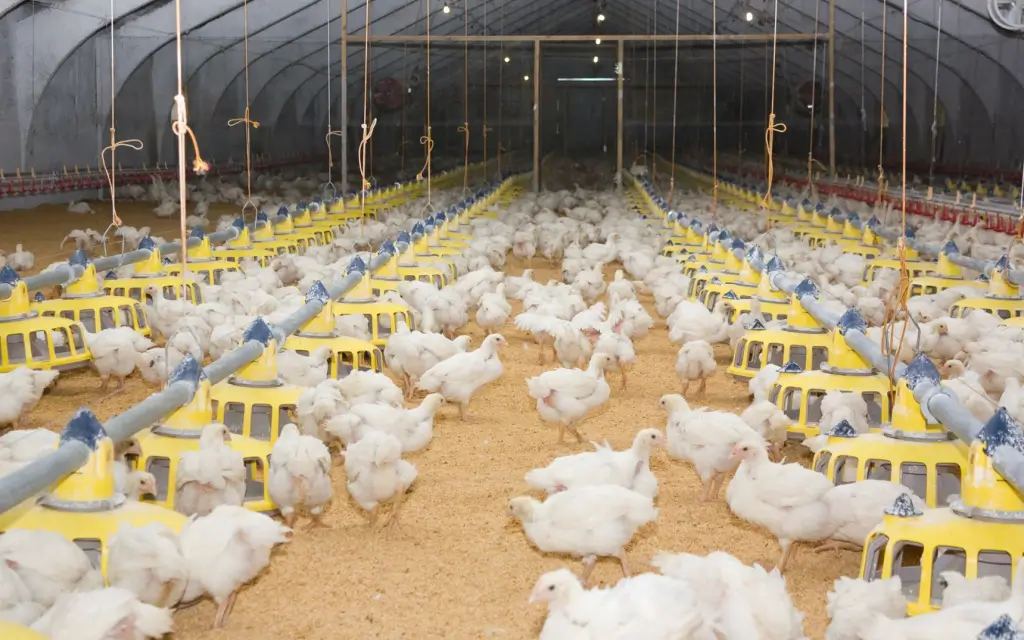Considering animal welfare and productivity, we think deep litter housing is the best intensive poultry system.
In a nutshell, conventional and enriched cage systems have the lowest animal welfare ratings. Similarly, the slatted floor system has poor affordances for natural behavior such as scratching and dirt bathing. On the other hand, the aviary system has lower productivity and lower egg quality in contrast to cage systems.
But are these reasons enough to make deep litter system the best of intensive poultry systems?
Deep litter housing system defined
The deep litter poultry housing system is one of eight poultry systems commonly used worldwide. Furthermore, these poultry systems are categorized under extensive and intensive systems. There are 5 intensive poultry systems. These are deep litter, slatted floor, aviary, battery cage and enriched cage systems.

In a deep litter system, litter from birds is allowed to accumulate on the floor, which is the living surface. Initially, bedding material such as wood shavings covers the ground. As a flock lives in the space, it accumulates litter. Consequently, this forms a deep litter which the system is named after.
For more info about deep litter and other poultry systems, read a previous article on poultry systems.
Why deep litter housing is best
As we briefly mentioned above, we have 2 reasons why we consider deep litter as the best intensive poultry system. Below, we delve into each of these to give some context to our reasoning below.
1. Animal welfare consideration
In our scoring, we rate enrich cage system lower than deep litter. In this one, we do not have to defend ourselves. Rather, we can piggy back on animal welfare. For instance, the EU already banned conventional cage system in 2012 and is set to ban all cage systems in 2027.
Consequently, all cage systems score lower than deep litter system, with conventional cage system scoring lowest of all.

High animal population in aviaries and high animal, we think, activity can result to stressed birds. As a result, we give aviaries a welfare rating of 2. Similarly, we rate slatted floor at 2. Slatted floor appears optimized toward produce cleanliness than animal welfare. By design therefore, slatted floor prevents natural behaviors such as scratching and dirt bathing.
Enriched cage in our opinion, is better than slatted floor and aviary, since it provides certain creature comforts furnishings. For this reason, we give it a welfare rating of 3.
2. Egg productivity consideration
Several studies comparing productivity in cage systems and aviary housing have been conducted. One by Mathews and Sumner, and another by Phillippe et. al.
From these studies, the aviary system has been found to have lower egg production rate than conventional and enriched cage systems. Phillippe et. al. have suggested lower productivity in aviary housing could be attributed to high and animal activity. This certainly implicates high animal population or crowding.

However, we do not yet have actual data comparing egg production rates between all intensive poultry systems. Such data would provide more support or less, for our case.
We assume there could a small difference in egg productivity between cage systems and deep litter. But we don’t think it is significant. We will update this section respectively as soon as we have some data in this regard.
Notably, the fact that aviary has lower productivity than cage systems that have low welfare ratings, does suggest that aviary are not suited to flock productivity.
What makes a good deep litter housing
Obviously, not all deep litter housing are made equally. However, irrespective of this fact, we think there are some key factors that make a good deep litter system.
Sufficient spacing affordance
This goes without saying; extra spacing is better than crowding. Since there regulatory requirements for spacing affordance in deep litter housing, abide by this. However, if possible go even further.

Extra space affordance can mean a number of things. For instance, birds can freely move about, scratch, and engage in dirt bathing. Additionally, birds are less likely to prey on each other when they have sufficient to move around.
Litter monitoring
Constant monitoring of litter condition is another factor that makes a good deep litter.
Sufficient nesting box provision
Having sufficient nesting boxes ratio by number of birds is essential to making a good deep litter housing. For one, it reduces the number of eggs that are laid on litter. This not only improves the percentage of clean eggs but also makes egg collection easier.

Sufficient nesting box provision also means that hens do not fight for access to the boxes. Consequently, less in-fighting means less possibility of egg breakage. Naturally, it means your hens are stress free. Stress free birds are likely to reach their productive potential.
Perching
Naturally, chicken like to perch. It is one activity in which individual and social behaviors take place. Therefore, providing perches or perching for your flock improves their well being.

Additionally, perches provides a resting and sleeping area. Although chicken need the scratching and dirt bathing activities afforded by deep litter, they also need a break from the litter. Perching provides that and enables them to engage in more intricate and natural behaviors.
*
Are we blowing this out of reality? Let us know what you think in the comments section below. For your curiosity, we have also weighed the the pros and cons of deep litter poultry system.

